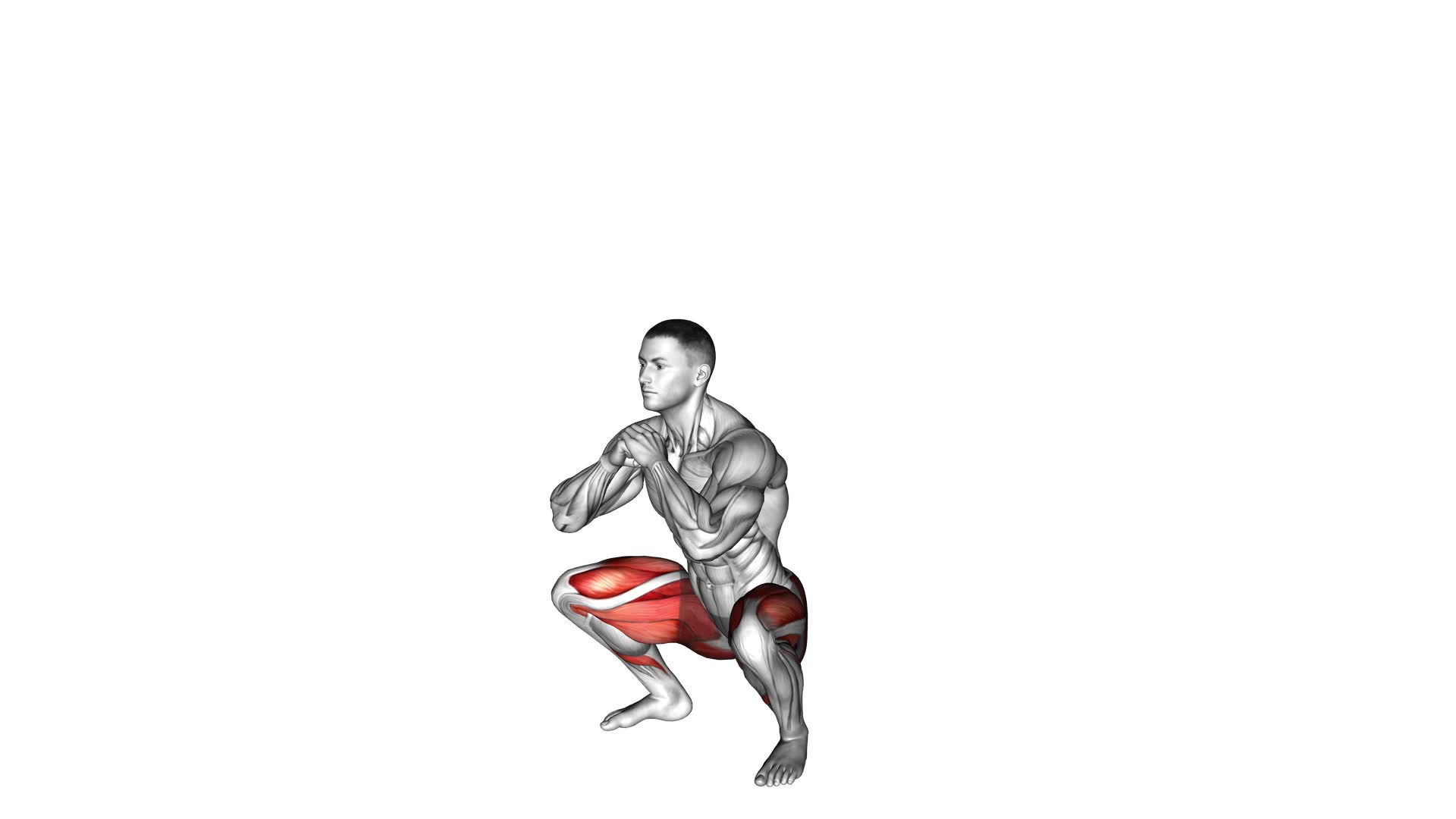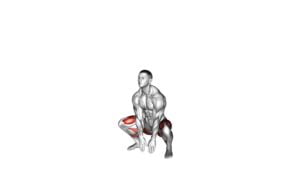Sumo Squat (male) – Video Exercise Guide & Tips

Are you looking to amp up your leg workout? Check out the Sumo Squat (male) – Video Exercise Guide & Tips!
Watch This Exercise Video
This informative guide will show you the proper form, highlight the benefits, and even offer variations to spice up your routine.
Avoid common mistakes and increase the intensity of your workout with expert tips.
Get ready to strengthen those legs and achieve your fitness goals with this dynamic exercise!
Key Takeaways
- Proper form and technique are essential for performing sumo squats correctly and effectively.
- Sumo squats can be modified and adapted to different fitness levels and goals.
- Incorporating sumo squats into circuit training routines or combining them with other compound exercises can provide a comprehensive full-body workout.
- Consistency and gradual progression are important for seeing improvements in strength, endurance, and flexibility with sumo squats.
Proper Form for Sumo Squat (male)
To perform the Sumo Squat (male) correctly, you need to squat down with your feet wider than shoulder-width apart. One common misconception is that the wider your stance, the better the exercise. However, this isn't entirely true. While a wider stance does engage the inner thighs and glutes more, it also puts additional stress on the knees. It's important to find a stance that's comfortable for you and allows you to maintain proper form throughout the exercise.
When it comes to equipment, you don't need much for the Sumo Squat (male). All you really need is your body and some space to move. However, if you want to add some resistance and make the exercise more challenging, you can use a kettlebell or a dumbbell. Holding the weight in front of your chest can help to engage the core muscles even more.
Remember to keep your chest up and your back straight throughout the exercise. This will help to protect your lower back and maintain proper alignment. As you squat down, focus on pushing your hips back and keeping your knees in line with your toes. This will help to engage the glutes and hamstrings while minimizing stress on the knees. Take your time and focus on performing the exercise with control and proper form.
Benefits of Sumo Squat (male)
Now let's explore the benefits you can gain from performing the Sumo Squat (male) exercise.
Sumo squats are a great way to build overall strength and power in your lower body. The wide stance and turned-out toes target your glutes, quadriceps, hamstrings, and inner thighs, helping to develop strong and powerful legs. By engaging these large muscle groups, sumo squats can also increase your overall calorie burn, making it an effective exercise for weight loss.
In addition to building strength and power, sumo squats can also improve your flexibility. The wide stance and deep squat position stretch your hips, groin, and inner thighs, helping to increase your range of motion in these areas. To further improve your flexibility in the sumo squat technique, you can incorporate dynamic or static stretches for the hips and inner thighs into your warm-up routine.
To get the most out of your sumo squat exercise, it's important to maintain proper form and technique. Make sure to keep your chest up, core engaged, and knees tracking over your toes throughout the movement. This will help to prevent any unnecessary strain on your lower back and knees. Additionally, focus on maintaining a controlled and slow descent into the squat position, and then drive through your heels to return to the starting position.
Incorporating sumo squats into your workout routine can provide you with a variety of benefits, including increased overall strength and power, improved flexibility, and enhanced calorie burn. Remember to always consult with a fitness professional before starting any new exercise program to ensure it's appropriate for your individual needs and fitness level.
Common Mistakes to Avoid
When performing the Sumo Squat (male) exercise, it's important to be aware of common mistakes that can hinder your progress and potentially lead to injury. One common mistake to avoid is improper breathing techniques. It's crucial to focus on your breath during the exercise to maintain stability and control. Take a deep breath in before lowering into the squat position, and exhale as you push back up. This helps engage your core muscles and provides stability throughout the movement.
Another mistake to be mindful of is common muscle imbalances. Sumo squats primarily target the glutes, quadriceps, and inner thighs. However, if you have weak glutes or tight hip flexors, it can lead to compensations and incorrect form. To prevent this, it's important to incorporate exercises that target these muscles and stretch tight areas before performing the sumo squat.
Additionally, it's crucial to maintain proper form throughout the exercise. Avoid rounding your back or leaning too far forward, as this can increase the risk of injury. Keep your chest lifted, shoulders back, and weight evenly distributed through your feet. Engage your core muscles to stabilize your spine and maintain a neutral position.
Variations to Spice Up Your Workout
To add some variety and excitement to your workout, try incorporating these variations of the Sumo Squat (male) exercise:
- Weighted Sumo Squats: Hold a dumbbell or kettlebell in front of your chest while performing the sumo squat. This adds resistance and increases the challenge for your lower body muscles.
- Pulse Sumo Squats: Instead of performing a full range of motion, pulse up and down in the sumo squat position. This keeps tension on your muscles and helps to burn more calories.
- Sumo Squat Jumps: Start in the sumo squat position and explosively jump up, extending your legs and arms. Land softly back into the sumo squat position and repeat for a cardio-focused variation.
- Sumo Squat with Side Kick: After performing a sumo squat, lift one leg to the side and perform a side kick. This engages your glutes, inner thighs, and core, providing a challenging variation to your workout.
Incorporating sumo squats into circuit training routines can be a great way to maximize your workout efficiency. You can include sumo squats along with other compound exercises like push-ups, lunges, and planks to create a full-body workout that targets multiple muscle groups.
This not only adds variety to your routine but also helps to improve strength, endurance, and overall fitness. Get creative with your modifications and enjoy the benefits of a challenging and effective workout.
Tips for Increasing Intensity
To further challenge yourself and increase the intensity of your workout, consider implementing these tips.
There are several ways to modify sumo squats for different fitness levels. If you're a beginner, start by using just your body weight and focusing on proper form and technique. As you become more comfortable, you can gradually add weights, such as dumbbells or kettlebells, to increase the resistance and make the exercise more challenging.
Another way to increase the intensity of your sumo squats is to incorporate them into a full body workout routine. By combining sumo squats with other exercises, such as lunges, push-ups, and planks, you can create a high-intensity circuit that targets multiple muscle groups and boosts your overall fitness level. This type of workout not only increases the calorie burn but also improves your strength, endurance, and coordination.
Additionally, you can try performing sumo squats on an unstable surface, such as a Bosu ball or a balance board. This requires more stabilization and engages your core muscles even further. It's important to note that these modifications should be done gradually and with proper form to avoid injury.
Incorporating these tips into your sumo squat routine will help you progress and reach new levels of fitness. Remember to listen to your body and adjust the intensity according to your capabilities.
Frequently Asked Questions
How Many Calories Does a Sumo Squat (Male) Burn?
Sumo squats are a great exercise for building overall leg strength. They engage multiple muscle groups, including your quadriceps, hamstrings, glutes, and calves.
By incorporating sumo squats into your workout routine, you can burn a significant amount of calories. The exact number of calories burned will depend on various factors such as your weight, intensity level, and duration of the exercise.
To maximize results, focus on maintaining proper form and technique throughout the movement.
Can Sumo Squats Help Improve Balance and Stability?
Sumo squats are a fantastic exercise for improving balance and stability. By widening your stance and turning your toes outwards, you engage your inner thigh muscles and activate your core. This helps develop a strong foundation and enhances your overall stability.
Additionally, the benefits of sumo squats extend beyond balance and stability. They also target your glutes, quads, and hamstrings, making it a great exercise for building lower body strength and toning your muscles.
Are There Any Specific Muscles Targeted by Sumo Squats That Are Not Mentioned in the Article?
When it comes to sumo squats, there are specific muscles that are targeted but not mentioned in the article. These include the adductor muscles, which are located on the inner thighs, and the gluteus medius, which is responsible for stabilizing the hips.
By performing sumo squats, you engage these muscles more compared to regular squats.
It's important to be aware of common mistakes like leaning too far forward or allowing the knees to cave inwards.
Can Sumo Squats Help With Knee Pain or Knee-Related Issues?
Sumo squats can be beneficial for knee rehabilitation and providing relief from knee pain. Unlike regular squats, sumo squats place less stress on the knee joints due to the wider stance and turned-out toes. This helps to alleviate pressure on the knees and reduce the risk of aggravating any knee-related issues.
Is It Recommended to Use Weights or Resistance Bands While Performing Sumo Squats?
Using weights or resistance bands while performing sumo squats can offer several benefits. They can increase the intensity of the exercise, helping to build strength and muscle in your lower body.
When using weights, make sure to maintain proper form and technique. Keep your feet wider than shoulder-width apart, toes pointed outwards, and squat down until your thighs are parallel to the ground. Engage your core and push through your heels to return to the starting position.
Conclusion
In conclusion, the sumo squat is a fantastic exercise for males that targets the lower body, particularly the quads, glutes, and inner thighs.
By maintaining proper form and avoiding common mistakes, you can maximize the benefits of this exercise, such as improved strength, balance, and flexibility.
Additionally, incorporating variations and increasing intensity will keep your workouts challenging and effective.
So, grab a pair of dumbbells and start incorporating sumo squats into your fitness routine for impressive lower body gains.

Author
Years ago, the spark of my life’s passion ignited in my mind the moment I stepped into the local gym for the first time. The inaugural bead of perspiration, the initial endeavor, the very first surge of endorphins, and a sense of pride that washed over me post-workout marked the beginning of my deep-seated interest in strength sports, fitness, and sports nutrition. This very curiosity blossomed rapidly into a profound fascination, propelling me to earn a Master’s degree in Physical Education from the Academy of Physical Education in Krakow, followed by a Sports Manager diploma from the Jagiellonian University. My journey of growth led me to gain more specialized qualifications, such as being a certified personal trainer with a focus on sports dietetics, a lifeguard, and an instructor for wellness and corrective gymnastics. Theoretical knowledge paired seamlessly with practical experience, reinforcing my belief that the transformation of individuals under my guidance was also a reflection of my personal growth. This belief holds true even today. Each day, I strive to push the boundaries and explore new realms. These realms gently elevate me to greater heights. The unique combination of passion for my field and the continuous quest for growth fuels my drive to break new ground.







